Is there a more highly anticipated new vehicle release in 2022 than the Ford Ranger? Nope, nothing else even comes close.
And while we’ve already brought you detailed coverage of the Ranger line-up from bottom to top, in this review we’re going all in on the 2023 Ford Ranger Wildtrak V6 4x4 dual-cab pick-up.
While the flagship Raptor ute also has a turbocharged V6 engine (albeit powered by petrol, not diesel), the Wildtrak is arguably a better ute if you intend to use your double-cab as a dual-purpose (or even multi-purpose) vehicle.
So in this test, we’ve done the stuff you’ll want to do if you’re considering a Wildtrak V6 - there’s a detailed driving section, a towing test with a near-three-tonne all-terrain caravan, and we’ve hit the rough stuff to see how it copes off road.
Let’s get to it.
Ford Ranger 2023: Wildtrak 3.0 (4X4)
| Engine Type | Diesel Turbo V6, 3.0L |
|---|---|
| Fuel Type | Diesel |
| Fuel Efficiency | 8.4L/100km (combined) |
| Seating | 5 |
| Price From | $67,320 - $77,440 |
| Safety Rating |
|
Does it represent good value for the price? What features does it come with?
8 / 10
You could save yourself three grand and buy the bi-turbo version of the Ranger Wildtrak, but then you’d be buying the wrong ute.
That’s because the V6 model justifies the additional asking price with its performance. More on that below. But you need to know the list price is $70,190 (MSRP - before on-road costs) for this spec, and that seems pretty good for what you’re getting.
Standard equipment includes 18-inch alloy wheels with Goodyear Wrangler Territory AT (255/65/18) all-terrain tyres, LED headlights with auto high beam and LED daytime running lights, LED tail-lights, LED zone surround lighting (extended puddle lighting), a sailplane for the tub, electronic roller cover hard top for the tub, and a plastic moulded tray liner.

The standard goodies list further includes a 12.0-inch portrait touchscreen, sat nav, AM/FM/DAB digital radio, wireless or wired Apple CarPlay and Android Auto, a wireless smartphone charger, five USB ports, dual zone climate control, heated front seats and electric seat adjustment for both front seats, a dark headliner and leather-accented trim with Wildtrak branding and embroidery.
Other great convenience features include front and rear parking sensors, a 360-degree surround-view camera system, a standard towbar with wiring and integrated electronic brake controller (new to the segment, and super handy!) and there’s a semi-autonomous parking system as well. Plenty more safety tech to think about too - that’s covered down below.

Our test car also featured the Wildtrak Premium Pack, which comprises a 10-speaker Bang & Olufsen stereo sound system, Matrix LED adaptive headlights and an overhead auxiliary switch back. Worth the extra $1500? Let me know what you reckon in the comments section.
Colour choices comprise Arctic White at no cost, while rest will set you back $675, and they include: Meteor Grey, Aluminium Silver, Luxe Yellow (which looks closer to orange, to me), Sedona Orange (more like light maroon) and Shadow Black. There is no green, no blue, no brown and no tan option.
Considering the rivals and their pricing, and the fact the new Wildtrak is only a few thousand dollars more than the last version, it seems pretty decent value.
Is there anything interesting about its design?
8 / 10
“It looks a bit like a Rivian!” said one observer. “The DRLS on those headlights look like Dame Edna Everidge’s glasses!” said another.
You will no doubt make your own mind up about whether you like the look of the new-generation Ranger, and the Wildtrak takes the style factor up a notch, too.
As mentioned above, the Wildtrak scores a few notable design upgrades over the lower-spec Sport, but still has dual front tow hooks, and an underbody skid plate, but upgrades from all-season to all-terrain tyres for its model-specific 18-inch wheels.

There are other exterior visual differences, too, like the sailplane, power roller cargo cover, and the grey look paint finishes on the bumpers.
As with the last model, the new one follows the “it’s inside that counts” mantra, with a bespoke interior trim to help it stand apart. I’ll cover the usability and practicality in the next section, but one thing is for sure - if you’ve sat in or owned a previous-gen Wildtrak, things are going to feel both familiar and unusual at the same time.

According to Ford, the new Ranger Wildtrak is a bit shorter nose-to-tail than the last one, at 5370mm (was 5446mm). The wheelbase is longer, and looks it, at 3270mm (was 3220mm), and it’s wider (2208mm inc mirrors) and taller (1886mm, was 1848mm).
All told, it looks more imposing, and has a wider track of 1650mm, making it look more planted than the last model which had a 1560mm track.
If you’re wondering about off-road angles, the approach is improved - now 30 degrees (was 29deg). The departure angle is also better at 23 degrees (was 21deg). But the break-over or rampover angle isn’t as good - it’s 21 degrees now (was 25deg) thanks to the longer wheelbase and ‘wheels at the corners’ stance.

Ground clearance is stated to be 234mm, which is 3mm less than before.
Official cargo dimensions for the Ranger are as follows: floor length - 1547mm; width - 1584mm; wheel-arch width - 1224mm; depth - 529mm. As such, you can fit a full size Aussie pallet in (1165mm by 1165mm), or two Euro pallets (1200mm x 800mm each) with the tailgate down.
The Wildtrak has a plastic tub liner and a hitch rail, as well as four tie-down points to secure a load.
One of the smartest design changes is the integrated step at the back side of the tub - it is easier to get up and into the tray using that step than trying to get a good foot-hold on the rear step bumper (or the tailgate, when it’s down).
I was surprised that while the Ranger has an assisted lift system for the tub’s tailgate, it still bangs down when you fling it open - some other utes have soft-opening functions, and it would be welcome for the Ranger.
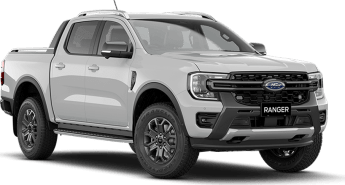
How practical is the space inside?
8 / 10
As I said above, the Wildtrak doesn’t stray too far from the playbook in this new-generation guise. There are orange highlights and dark materials everywhere, so it feels familiar.
The changes are easily noticeable, though - that 12.0-inch portrait style touchscreen system is the biggest one, and it won’t be to all tastes.
That’s because it really does command a lot of space, and also a lot of driver concentration. The layout - essentially two horizontal screens stacked on top of each other - is fine, but the controls you will find yourself using more of the time are anchored down the bottom.

In fact, there’s an odd doubling up of controls - the Ranger (thank you, Ford!) persists with some physical dial and button controls for air-conditioning, fan speed, recirc, demister, volume and tuning, though most of those are then digitally mirrored above that section, and they can be annoying because they’ll stick around on the screen longer than you might want them to.
That’s a common theme with the screens - the information does get to be close to overload levels. The 8.0-inch digital driver info screen is constantly throwing up screens with warnings that you need to cancel out of using the steering wheel buttons, accompanied by bings and bongs and warning chimes. It can be frustrating at times.
I’ll say this - after a few days of driving and spending time in the Ranger Wildtrak, I reckon you’re only going to use about 20 per cent of the functionality of the screens. Especially if you end up plugging in or wirelessly connecting your smartphone for CarPlay or Android Auto mirroring.
As for storage, there is a dual glovebox setup, and it’s nice to see the dashboard is flanked by pop-out cupholders. There are two more cup/bottle holders between the front seats, drink storage slots in the doors, and a decent sized centre console bin, not to mention a Qi wireless charging pad in front of the shifter.
Seat comfort and adjustability is good, and there’s ample support from the front seats - aided greatly by the inclusion of reach and tilt adjustable steering. Thank goodness for that.
As for the space in the back? The longer wheelbase doesn’t necessarily translate to a notably bigger cabin - I’m 182cm or 6’0” and I could fit behind my own driving position, but the space would be best described as adequate rather than ample for knee room, toe room and headroom. Three across would be tight, especially for larger adults who might find it squeezy, and there’s still an element of ‘sit up straight’ because of the upright backrest design.
There are dual ISOFIX points for the window seats and two top-tether attachment points, too, but stay tuned for a FamilyGuide review of the Ranger to see how it stacks up for child-seat duties.
What are the key stats for the engine and transmission?
9 / 10
Wondering why you should choose the optional 3.0-litre turbo-diesel V6 instead of the 2.0-litre bi-turbo? The answer is this - 184kW of power (at 3250rpm) and 600Nm of torque (from 1750-2250rpm).
That’s 30kW and 100Nm more than the four-cylinder bi-turbo option, but it’s the drivability of the big six that impresses most. More on that soon.
Handling progression is a 10-speed automatic transmission. No paddle-shifters - instead, Ford has its e-shifter with shift buttons, which is hard work at times.
And while the brand might market this Ranger as offering “Full-Time 4WD”, there is a dial selector that allows you to choose between 2H, 4H, 4L and 4A - the latter being the four-wheel drive automatic system that can vary drive to the front and rear axles as required.
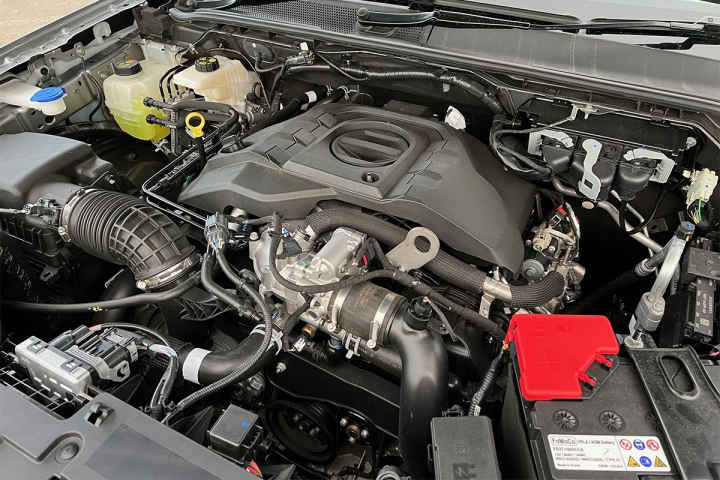
Also of note are the Wildtrak V6’s six driving modes: Normal, Eco, Tow/Haul and Slippery for on-road driving, and Mud/Ruts and Sand for off-road use - and each drive mode adjusts throttle, transmission, braking, traction and stability controls.
Other key stats? There’s 750kg unbraked towing capacity and up to 3500kg braked towing. Just keep in mind you’ll need to be aware of your payload limitations if you plan to tow 3500kg.
The gross combination mass (GCM) is 6400kg for Wildtrak V6, and if you take 3500kg off that, you’re left with 2900kg. The kerb weight is 2399kg, so that leaves you just 501kg to play with. For a family of four, that may mean you’ll have to pack light for your camping trip in the big ‘van.
However, if you’re not towing something at maximum towing capacity, the gross vehicle mass (GVM) is 3350kg - allowing 951kg of payload.
How much fuel does it consume?
7 / 10
The official combined cycle fuel consumption figure for the Wildtrak V6 is 8.4 litres per 100 kilometres, which seems pretty good for a big heavy truck with a big hunk of an engine.
In reality, across a mix of driving, we saw a higher fuel use return.
Our unladen drive loop on-road saw a return of 11.5L/100km - thirstier than expected. Add our serious off-road test run and that number ended up at 15.4L/100km combined. Not terrific, but also not what you’ll likely be doing with it on a daily basis.

But then when we doubled down on that loop towing the 2800kg-plus Avida Topaz all-terrain caravan, we saw a relatively impressive return of 19.4L/100km. For the driving we did - highway, urban, rough country roads and more - that seemed a decent number.
Interestingly, there is fuel-saving engine start-stop technology in operation in the V6 Ranger, but it doesn’t run AdBlue.
What's it like to drive?
9 / 10
This wasn’t just a regular drive test - in this Ranger Wildtrak V6, we put it through its paces. Towing a 2800kg-plus dual-axle caravan; negotiating a seriously craggy and washed-out four-wheel drive track; and a road test loop with more of the regular stuff you’ll encounter day-to-day.
Unladen driving
Of course, the highlight is the V6 engine, which offers immense grunt and a surprisingly refined and quiet experience.
There’s ample pulling power with just one occupant on board, and it never feels short of puff. Sure, there’s a little bit of lag from a standstill, but the transmission does a good job of ensuring you never run out of options when you’re at speed.
That 10-speed auto is really great, too. There are - obviously - lots of gears to play with, and it just helps the engine feel like it’s doing it easy. And yes, it will get into tenth gear - I noticed it shuffle itself to top gear on a flat freeway at 110km/h.
The suspension of the Wildtrak V6 is nicely settled in most situations. On open roads, highways and lower speed urban driving it remains nicely calm and composed, even without a load in the back. However, I noticed that it could be a bit wobbly over country roads with lots of lumps and bumps
The steering remains a sweet element of the new-generation Ranger (it scored a big tick in the last one, too), with a lovely precise action and light feel to the wheel, which means it’s just easier to move the vehicle around in traffic or when parking.
It is still a big thing, but the surround view camera makes a massive difference when you’re trying to slot it into a parking space. I just wish the camera view filled the screen more, rather than leaving blank space either side.
The biggest letdown for me was the brake pedal feel and response. There’s a dull spot at the top of the pedal where it feels like the brakes should bite, but they don’t until you’re almost halfway down the pedal, before getting really grabby. This is something that you might get used to, but it caught me off guard, and for our off-road loop, it made Crafty a bit nervous, too.
Off-road (by Marcus Craft)
Now with a V6 engine, a new permanent 4WD system and even more driver-asst tech then ever before you’d be safe in assuming the Wildtrak is even better than the last version. Well, it is – on paper, at least. But in the real world – on bush tracks – an off-road vehicle’s weaknesses are often swiftly exposed. As they were here.
First up, its strengths: The V6 engine offers plenty of torque across a decent rev range and is a welcome addition to this ute. Low-range gearing is adequate and the Ranger has an electronic rear diff lock for more dirt-gripping control.
The off-road driving modes include Mud/Ruts and Sand and, while these are mostly novelties in contemporary 4WDs and are no substitute for track-worthy 4WD mechanicals, these modes do effectively adjust the characteristics of engine throttle, transmission, braking, traction and stability controls to suit the driving conditions.

Now, for the not-so-good: The Ranger is hamstrung by its sheer physical dimensions – as is the case with some of its contemporary rivals. The driver has to always be mindful of those and drive with a carefully measured approach not required in some other dual-cab utes, namely something like the Pro4X Warrior. Its extended wheelbase especially impacts the Ranger’s ability to traverse sharply-angled rock steps without experiencing bumps to the undercarriage or scuffs to the side-steps. If you want to avoid belly-scraping and sidestep run-ins with rock, tree stumps or fallen tree branches, it’s something to keep in mind.

The tyres are all-terrains, but if you’re serious about off-roading you’ll probably want to upgrade them to a more aggressive set. Wider rubber wouldn’t hurt, either, and nor would a mild lift kit (two inch or so).
The track-view/360-degree camera and vehicle-info read-out (displaying driveline/diff lock indicators, and steering, pitch and roll angles) – are fun additions, but more novelty than necessity. The front camera, aimed at offering the driver more ground-level visibility than you’re afforded over the huge bonnet, offers a warped fish-eye view of the track (or maybe that’s the fault of my old codger eyes), is affected by the mix of bright sunlight and deep shadows of thick bushland – and I still don’t know how accurate the wheel track indicators actually are.
It’s nice to drive, comfortable and packed full of tech – but I reckon it’s better suited to towing and open-road/track recreational duties than being used as a hardcore 4WD.
Towing
The last Ranger had a really clever ‘zoom’ button for the reversing camera to allow you to easily line up your tow ball with the receiver. That feature doesn’t carry over to the new Wildtrak, but it was still really easy to line up the ute with our test caravan to hitch up.
The caravan in question was loaned to us by our mates at Avida - it’s a Topaz CV7054SL all-terrain ‘van (maybe we should have swapped the tyres from the van to the ute?!), weighing in at 2800kg tare weight, though our test van weighed a little more due to some additional ballast inside.
Still, well within the 3.5-tonne maximum braked towing capacity of the Ranger.
Now, I mentioned the brakes in the unladen driving section, and they rate more of a mention here. That’s because the Ranger offers a segment-first standard-fit electronic brake controller system in this spec.

That means that, just like in a Ram 1500 or Ford F-150, there’s a built-in toggle to adjust the gain for the trailer brakes. It’s very neat, and tidier than an aftermarket Redarc toggle (and you don’t have to pay extra to get it!). The tow bar assembly with wiring is standard on Wildtrak, too.
Other interesting elements for the towing setup was the fact it can check your brakes, hazards and blinkers for you, and if you set a ‘profile’ for the caravan, trailer or horse box behind you (length, width) it will adjust the car’s electronic safety systems - including blind spot monitoring - to help you tow more easily.
All of that is ‘big truck’ thinking, and all of it is welcome. I hit the road for a mixed loop with open road, highway, freeway, urban and country testing, and the Ranger was mostly very good to tow with.
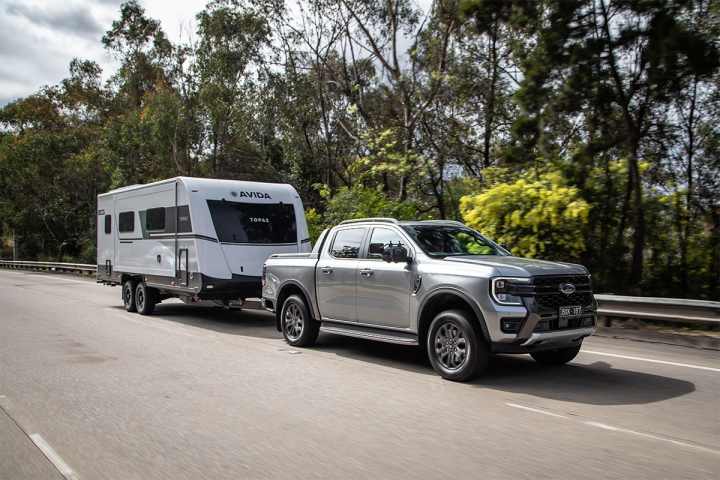
It felt settled, planted and controlled on smooth surfaces, with the suspension doing a terrific job provided you weren’t encountering lots of lumpy bumps. On the part of our loop that did include that oh-so-typical style of road surface in Australia, I found the Ranger to almost feel too soft - the body felt as though it was wobbling on top of the suspension a bit. It wasn’t getting pushed from behind like I’ve felt in some other utes, but it wasn’t quite as confident in those situations, even at 80km/h or less.
However, once again, the steering was terrific, offering a very predictable experience for the driver.
And the Wildtrak’s progress was hardly affected by the fact it was hauling almost three tonnes behind. The ute loped along at 100km/h on the freeway, engaging 10th gear and cruising at 1500rpm.

The V6 engine and 10-speed auto got the job done with minimal fuss, easily lugging the weight and hardly even losing momentum up our steep hill climb (Lapstone Hill at the foot of the Blue Mountains), dropping logically to sixth gear and maintaining 80km/h at half throttle.
All told, it towed very well. Just be mindful that it might be a bit too spongy if you do a lot of rough country road driving.
Warranty & Safety Rating
What safety equipment is fitted? What safety rating?
10 / 10
Setting a new benchmark for the ute segment for safety seems to be something that comes along every few years - most recently the Mazda BT-50 and Isuzu D-Max twins set it, and now the new-generation Ranger has gone and reset it.
As with all grades, the Wildtrak brings nine airbags (dual front, front side, driver and passenger knee airbags, curtain airbags for both rows and a centre front airbag to prevent head collisions), not to mention front AEB (autonomous emergency braking), adaptive cruise control with speed sign recognition and speed adaptation (you can turn it off), lane departure alert and lane keep assist, and blind spot monitoring and rear cross-traffic alert that covers the ute itself and the trailer, when you set up a profile when towing.
There’s also reverse brake assist, a form of rear AEB that will hit the anchors if you’re about to back into something, tyre pressure monitoring, a 360-degree surround view camera, front and rear parking sensors, auto parking system and even a trailer light check system when you hook anything up at the towbar - meaning you can let the system do the check for you, rather than having to put a brick on the brake and do laps of the ute to check the turn signals and lights. Just note - it takes a few minutes to do its thing.
What does it cost to own? What warranty is offered?
8 / 10
Ford hasn’t necessarily changed the game with its ownership plan - it still offers a five-year/unlimited kilometre warranty, which is now the average level of cover. If you want a longer warranty, you could look at an Isuzu D-Max, which has six years of warranty, or a Mitsubishi Triton, which offers up to 10 years/200,000km of conditional warranty cover (if you service your car at Mitsubishi dealerships).

Beyond that, Ford offers a five-year plan for roadside assist, and a capped-price service plan that is cheap for the first four visits. Intervals are set every 12 months or 15,000km - and the maintenance cost for the first 48 months/60,000km is capped at $329 per visit, even for the V6 versions. That’s a hell of a lot cheaper than the existing VW Amarok V6.
Worried about Ford Ranger problems? Concerned there could be reliability issues, engine problems, transmission issues or any other question marks over ownership? Head to our Ford Ranger problems page.
Verdict
There is no denying that the Ford Ranger Wildtrak V6 is a compelling option for those who want more out of their dual-cab ute than just a work truck.
After a few exhaustive days of testing, it showed itself as a competent (though not faultless) off-roader, a decent tow vehicle (especially on the highway/freeway), and a very liveable daily driver. Its tech-focused cabin mightn’t be to all tastes, but it really is a big step forward for the Ranger, and the midsize ute segment.
Pricing Guides



.jpg)
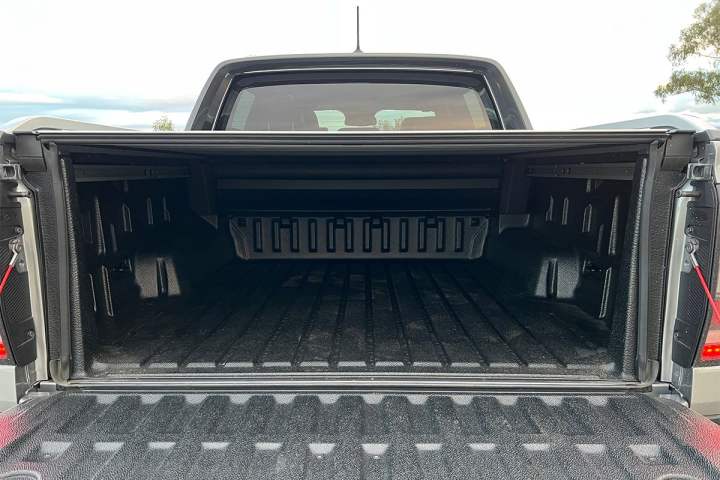









.jpg)
.jpg)
.jpg)

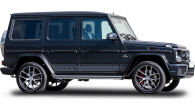


.jpg)


.jpg)
.jpg)




.jpg)

Comments